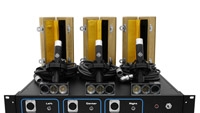Telefunken announces the return of the Decca Tree

Connecticut-based Telefunken Elektroakustik announced the introduction of the ELA M 260 TRI-MONO System at AES New York. A modern version of the classic Decca Tree capture system, the Tri-Mono is comprised of three matched ELA M 260 small-diaphragm tube microphones, a custom M 963 TRI-MONO three-channel power supply, and adaptor spheres to emulate the omni effect of the original "Decca Tree" configuration introduced in the 1950s.
The TRI-MONO set of ELA M 260 small diaphragm tube microphones features three interchangeable capsules for each mic (cardioid, hyper-cardioid and omni). The addition of both 30mm and 50mm adapter spheres allows the ELA M 260 omni capsule to be adapted to a spherical omni design emulating the prized effect achieved by the capsules found in original Decca Tree Neumann M50 microphones.
A custom M 963 TRI-MONO 2U rack space power supply has been designed to power all three microphones at one time. The TRI-MONO system also includes three, 25ft, right angle tube mic cables, elastic shock mounts and wooden microphone boxes.
"First developed over 50 years ago, the 'Decca Tree' utilized three matched Neumann omnidirectional M50s," explained Jason Scheuner, Telefunken artist liaison. "It is nearly impossible to find those mics today, and if you do, the price is extremely high.
"We have created this new TRI-MONO configuration using our own ELA M 260s plus two sets of adaptor spheres to emulate the original design, which accommodated small, medium, and large recording spaces."
Telefunken's TRI-MONO system presents a very affordable modern equivalent of the time-honored method of recording with a strictly spaced mic array, commonly used for orchestral recording in large spaces. The technique was first used commercially in 1954 by the recording team at Decca Records to provide a strong stereo image. The left and right mics are placed about six feet apart, and the third is placed three feet out and centered in front. To mix, the side mics are panned hard left and right, and the output of the middle mic is then sent to both left and right channels.
Before finalizing the design of the ELA M 260 TRI-MONO microphone system, Telefunken conducted extensive beta tests at some of the nation's top recording facilities, including Skywalker Ranch, Meyer Sound Laboratories, and at Bob Weir's TRI Studios in Northern California.
Get the TV Tech Newsletter
The professional video industry's #1 source for news, trends and product and tech information. Sign up below.
